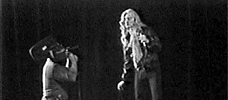Reviews
Harmony Korine
UK / France / Ireland / USA, 2007
Credits
Review by Rumsey Taylor and Katherine Follett
Posted on 02 May 2008
Source IFC Films 35mm print
Categories The 2008 Independent Film Festival of Boston
One of the first questions asked at the IFF Boston Q-&-A with director Harmony Korine (and did about one-in-five of the attendees have Asperger’s or something?) was “What do the nuns have to do with the impersonators?” You got the sense that he’d been asked this a lot. And he answered with a rather pointedly personal, “I don’t really feel like telling you.” (I just might count Korine as one of those one-in-five.) But it was difficult not to read these two parallel stories - one of a Michael Jackson impersonator who joins an impersonator-commune that includes a beautiful “Marilyn Monroe” and an “Abraham Lincoln” prone to obscenities; and the other of a group of nuns, led by pilot Werner Herzog, who decide they must jump parachuteless from airplanes in order to demonstrate their faith - as two separate, if related films.
The issue of coherence notwithstanding, both portions result in some highly vivid imagery. Much of the film consists of interactions between cultural icons from different eras (“Monroe” is married to “Charles Chaplin,” for example), but the film is less about interaction than it is feeling. As such, the narrative that strings many of the scenes together is slight, and the film is better described as a collection of images for which coherence is largely moot. Nuns skydive in snowflake formations. “Michael Jackson” speaks sympathetically to an audience of hard-boiled eggs. And “Monroe” and “Chaplin” have given birth to daughter “Shirley Temple.”
The effect is at first a bit disorienting. Each of these icons is familiar - except for the skydiving nuns, that is - but they’re placed in isolation without the contexts that define them—without their fame and some without their art. The most iconic image of “Marilyn Monroe” is repeated throughout the film, but later she’s seen in a swimsuit with a rather excessive sunburn. When this occurs, this character emerges neither as Marilyn Monroe nor as the woman impersonating her, but as a mixture of two disparate sensibilities, one entirely authentic, and one entirely feigned.
Conveniently this describes the nature of Korine’s film—that one of its portions is to be construed as imagination, an extrapolation, perhaps, of the themes addressed in the other portion. It seems, however, that to Korine they are one movie. And when one does consider the common themes, the mind seems to want to give them greater depth for being dealt with twice rather than once. Both plots involve groups who have voluntarily exiled themselves; both groups seem ill-suited to the self-sufficiency they have taken on; both are led by an intense man whose controlling nature only ends up sparking chaos; both expose themselves to harm and ruin in order to be faithful to their own odd ideas about how to live comfortably in one’s own body. The issue is that the film encourages juxtaposition of its two distinct parts.
I certainly don’t mind if a filmmaker works with the same ideas and themes in more than one film, but while the two portions of Mister Lonely spoke to each other, I don’t think they necessarily formed a single whole. But the two films still operate as separate meditations on some of the same themes. Perhaps if they had been presented as two films, instead of interwoven, each would be less resonant with the other, and therefore with the audience. But then what about the themes that only seem to be dealt with in one or the other? The impersonators deal with identity, while the nuns, not so much. Religion didn’t play much of a role in the impersonator’s compound, and sex was almost nonexistent with the nuns. Are these ideas less worthy of inspection?
In the Q-&-A, Korine reiterated his disinterest in narrative filmmaking (this was tantamount to his reluctance to answer particular questions), and this disinterest is clear in Mister Lonely. But this film - Korine’s third feature - is much less abstracted and more narrative-driven than either Gummo or julien donkey-boy. The main character, “Michael Jackson,” does follow a clear narrative arc over the course of the film, even if the events that draw him along are non-sequiturs, improvised comedic vignettes, and scenes from a totally separate, if thematically similar, plot. And the human brain naturally gravitates toward stories, toward finding meaning in narrative rather than in assembled unrelated images. Korine obviously intends to communicate meaning with these assembled unrelated images, and indeed, many of the images are visually moving. But the film’s strongest parts are its recreations of actual human lives, no matter how surreal or quirky. A director like Korine moving toward more traditional narratives is like a beloved cult musician bringing song structure and melodies to what was formerly noise. To purists and lovers of abstraction, challenge, and all things fringe, it may feel like a loss of authenticity. But to the larger mainstream audience, it simply makes art more accessible, and possibly widens the range of what’s considered mainstream.
More The 2008 Independent Film Festival of Boston
-

Crawford
2008 -

Vexille
2007 -

American Teen
2008 -

Mister Lonely
2007 -

Intimidad
2008 -

Meadowlark
2008 -

Second Skin
2008 -

Transsiberian
2008 -

The Linguists
2008 -

Big Man Japan
2007 -

At the Death House Door
2008 -

The Beaver Trilogy
2000 -

The Beaver Trilogy
2000 -

Nerdcore Rising
2008 -

Goliath
2008 -

The Tracey Fragments
2007 -

Saviours
2008 -

Medicine for Melancholy
2008 -

Severed Ways
2007 -

Not Your Typical Bigfoot Movie
2008 -

Not Your Typical Bigfoot Movie
2008 -

Jump!
2007 -

Encounters at the End of the World
2007
We don’t do comments anymore, but you may contact us here or find us on Twitter or Facebook.



